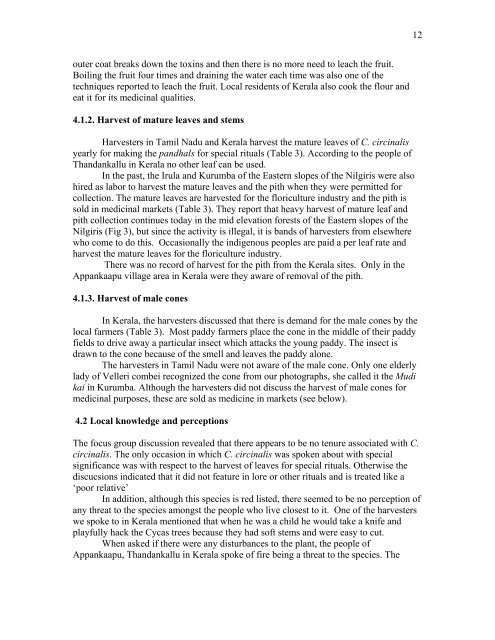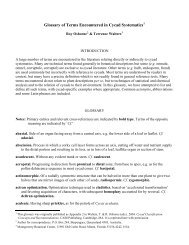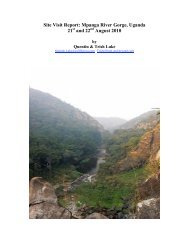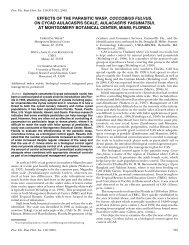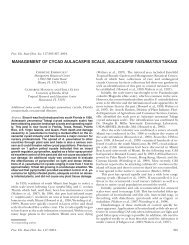Cycas-circinalis-cas.. - Cycad Specialist Group
Cycas-circinalis-cas.. - Cycad Specialist Group
Cycas-circinalis-cas.. - Cycad Specialist Group
You also want an ePaper? Increase the reach of your titles
YUMPU automatically turns print PDFs into web optimized ePapers that Google loves.
outer coat breaks down the toxins and then there is no more need to leach the fruit.<br />
Boiling the fruit four times and draining the water each time was also one of the<br />
techniques reported to leach the fruit. Local residents of Kerala also cook the flour and<br />
eat it for its medicinal qualities.<br />
4.1.2. Harvest of mature leaves and stems<br />
Harvesters in Tamil Nadu and Kerala harvest the mature leaves of C. <strong>circinalis</strong><br />
yearly for making the pandhals for special rituals (Table 3). According to the people of<br />
Thandankallu in Kerala no other leaf can be used.<br />
In the past, the Irula and Kurumba of the Eastern slopes of the Nilgiris were also<br />
hired as labor to harvest the mature leaves and the pith when they were permitted for<br />
collection. The mature leaves are harvested for the floriculture industry and the pith is<br />
sold in medicinal markets (Table 3). They report that heavy harvest of mature leaf and<br />
pith collection continues today in the mid elevation forests of the Eastern slopes of the<br />
Nilgiris (Fig 3), but since the activity is illegal, it is bands of harvesters from elsewhere<br />
who come to do this. Oc<strong>cas</strong>ionally the indigenous peoples are paid a per leaf rate and<br />
harvest the mature leaves for the floriculture industry.<br />
There was no record of harvest for the pith from the Kerala sites. Only in the<br />
Appankaapu village area in Kerala were they aware of removal of the pith.<br />
4.1.3. Harvest of male cones<br />
In Kerala, the harvesters discussed that there is demand for the male cones by the<br />
local farmers (Table 3). Most paddy farmers place the cone in the middle of their paddy<br />
fields to drive away a particular insect which attacks the young paddy. The insect is<br />
drawn to the cone because of the smell and leaves the paddy alone.<br />
The harvesters in Tamil Nadu were not aware of the male cone. Only one elderly<br />
lady of Velleri combei recognized the cone from our photographs, she called it the Mudi<br />
kai in Kurumba. Although the harvesters did not discuss the harvest of male cones for<br />
medicinal purposes, these are sold as medicine in markets (see below).<br />
4.2 Local knowledge and perceptions<br />
The focus group discussion revealed that there appears to be no tenure associated with C.<br />
<strong>circinalis</strong>. The only oc<strong>cas</strong>ion in which C. <strong>circinalis</strong> was spoken about with special<br />
significance was with respect to the harvest of leaves for special rituals. Otherwise the<br />
discucsions indicated that it did not feature in lore or other rituals and is treated like a<br />
‘poor relative’<br />
In addition, although this species is red listed, there seemed to be no perception of<br />
any threat to the species amongst the people who live closest to it. One of the harvesters<br />
we spoke to in Kerala mentioned that when he was a child he would take a knife and<br />
playfully hack the <strong>Cy<strong>cas</strong></strong> trees because they had soft stems and were easy to cut.<br />
When asked if there were any disturbances to the plant, the people of<br />
Appankaapu, Thandankallu in Kerala spoke of fire being a threat to the species. The<br />
12


